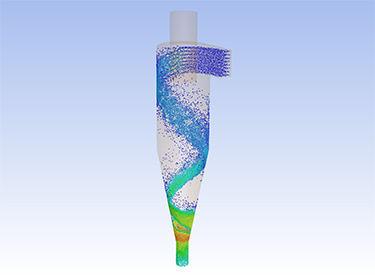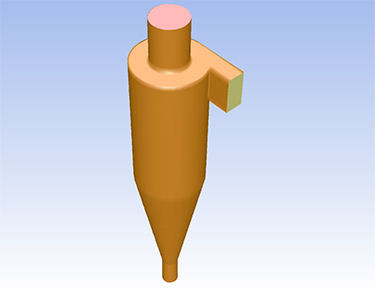Simulating the Performance of Solid Cyclone Separators
Latest News
August 28, 2014
 Dear Desktop Engineering Reader:
Dear Desktop Engineering Reader:
I once tried to impress on my son that I expected a sorta clean bedroom by wielding a leaf blower as if I were a Samurai housecleaner. The cyclonic effect of the blower’s jet stream worked better than expected: papers, empty soda cans and socks flew to the sides of his room, making a path across the floor. You’ll find more industrious usages for cyclonic separation at the other end of today’s Check it Out link.
All sorts of industries use cyclonic separation to detach particulates like dust, grit and microscopic droplets from materials under development. In oil and gas processing, cyclonic separators split apart oil and gases. The cement industry relies on cyclonic separation in equipment like gas-suspension preheater kilns to start the process of making clinkers.
Among the attributes that make cyclone separators attractive in industrial processes is that they have no moving parts, consume power modestly compared to other machinery, and have no filters to replace. They can be huge even mobile machines, yet they are geometrically simple. Essentially, you have a tube with inlets for the materials to be separated and air system, a conical core through which materials flow and outlets for gases and desired and unwanted materials.
Geometric simplicity, however, does not mean the physics are simple. To design a high-performance cyclone separator, you need to optimize the air system’s gas pressure drop and pumps sizing while maximizing the efficiency of solid separation. Today’s Check it Out link takes you to a web page titled “Simulating the Performance of Solid Cyclone Separators,” where you’ll find a variety of information on simulation solutions ANSYS offers for this job.
The highlight of the page is a 6-minute 16-second video right in the middle. This registration-free video, the fourth in a series called “Multiphase CFD Insight,” provides a step-by-step demonstration of how you can use ANSYS CFD (computational fluid dynamics) technology, primarily ANSYS Fluent, to simulate the performance of a solid cyclone separator.
The demonstration features three key ANSYS capabilities. First, there’s DEM (discrete element model), an intriguing technology for simulating particle interactions like particles bumping into each other and the wall. Second is something called a Dense DPM (Dense Discrete Particle Model), which enables you to consider the effects of particle blockage on gas flow. Finally, the demo uses validated dispersed RSM (Reynolds stress model) turbulence models to simulate the swirling flows inside the cyclonic separator.
The video looks at the prediction of pressure drop and particle flow pattern for a dense medium cyclone separator with variations in solid loading. It quickly takes you through parameter set-up, such as operating conditions, particle properties, cyclone dimensions and so on. It also provides the physics description of the problem being explored. The video provides animations showing the effects of particulate flow patterns on gas pressure. Graphs comparing ANSYS predictions to experimental data show a good convergence.
For those of you most interested in the capabilities demonstrated here, especially DEM, look at the top right of the landing page. There you’ll find a banner for an on-demand webinar called “Introduction to Multiphase Models in ANSYS CFD.” It’s part two of a three-part series. The first part was the beginner’s introduction to modeling multiphase flows.
The second webinar covers the discrete particle model, which you can use to model sprays, pneumatic particle transport and, of course, cyclones. Also covered is the volume of fluid method, which you can use to model flows like slug flows and open channel flows. Registration is required.
The “Simulating the Performance of Solid Cyclone Separators” web page is part of the ANSYS Technology Tips initiative. As has become ANSYS’ style, you’ll also find on this page a wealth of high-quality supplementary data ranging from white papers to applications briefs and from on-demand webinars to case studies. Hit today’s Check it Out to get at this good stuff. If time is tight, make use of it and take in the video. It’s impressive.
Thanks, Pal. – Lockwood
Anthony J. Lockwood
Editor at Large, Desktop Engineering
Access the “Simulating the Performance of Solid Cyclone Separators” web resource here.
Subscribe to our FREE magazine, FREE email newsletters or both!
Latest News
About the Author
Anthony J. Lockwood is Digital Engineering’s founding editor. He is now retired. Contact him via [email protected].
Follow DE







